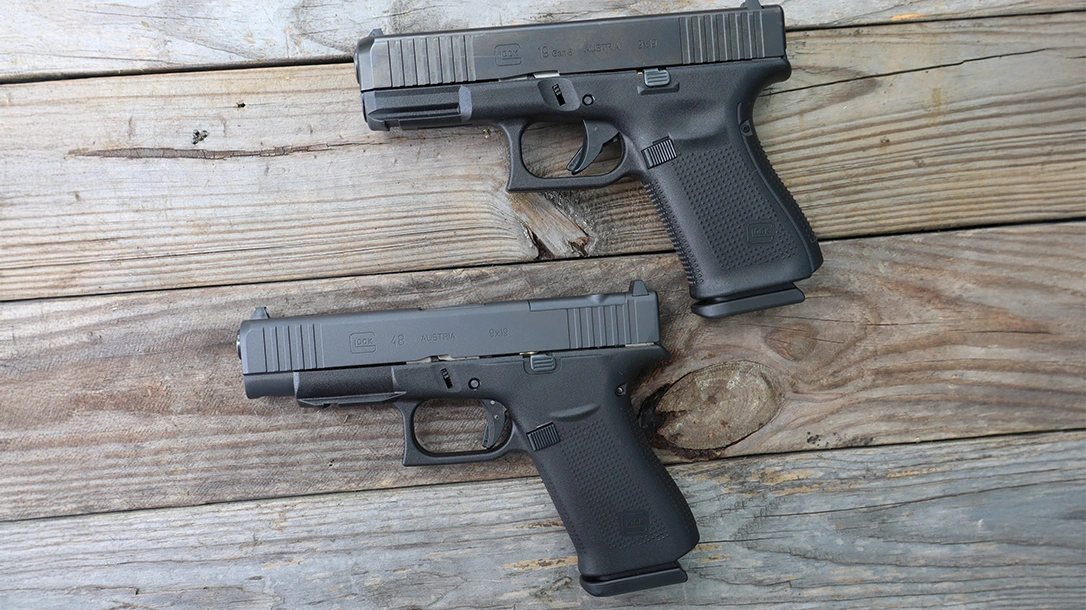The Glock 19 and Glock 48 were designed with a certain intent, and both have their respective fans. Both are polymer-framed striker-action handguns and are chambered in 9mm Luger. In addition, both are couched in what could be described as a compact footprint. That begs the question: What is the difference between the Glock 19 vs. the Glock 48? And how do those differences matter? Let’s have a look at both and put them through their paces with some live fire.
Glock 19 vs. Glock 48
The Glock 19: It Hardly Needs Introducing
The Glock 19 came out in 1988. It is functionally the same as the double-stack Glock 17 pistol that launched the Glock brand three years previously. The G19 features a slightly shorter 4-inch barrel and a shorter grip. The grip cut magazine capacity to fifteen rounds. However, the overall package was made as a duty gun that is slightly easier to put on the belt.
The 19 predates the micro-compact and even the single-stack compact pistols designed expressly for concealed carry. It also predates the Glock 26—a chopped-down version of the 19.
Advertisement — Continue Reading Below
In spite of its size, the Glock 19 has been a staple for concealed carry. The following only proved more durable thanks to the 19’s popularity with police departments, military units, and competition shooters. Pistols, holsters, and aftermarket parts are among the very best in the industry.
If any Glock 19 clone is taken as evidence, it’s possible to spec up a Glock pistol without any Glock parts.
Advertisement — Continue Reading Below
Another reason for its widespread popularity and aftermarket base is the fact that the Glock 19 has changed very conservatively over the years. Gen 3 Glock pistols have improved stippling and trigger reach. The Gen 4 features a dual-recoil spring for less recoil and muzzle rise. The recent Gen 5 Glock 19 has added ambidextrous controls, forward and rearward cocking serrations, and a potential optic-ready configuration with the MOS version of the G19.
Glock 19 Quick Specs
| Caliber | 9mm Luger |
| Capacity | 15+1 |
| Barrel Length | 4.0 inches |
| Overall Length | 7.0 inches |
| Slide Width | 1.0 inches |
| Overall Width | 1.25 inches |
| Height | 5.0 inches |
| Weight | 1 lb. 14.5 oz. (loaded) |
The New Challenger: The Lean, Mean Glock 48
Single-stack handguns are prized for their slim profile over traditional handguns that use double-stack magazines. A slimmer grip and slide make for a more comfortable and concealable handgun to carry inside-the-waistband. Single-stack 9mms dominated the 2010s. But for too long, Glock was not among them.
Advertisement — Continue Reading Below
The small six-shot Glock 43 Slimline debuted in 2015, but small handguns in a service caliber are harder to shoot. That resulted in the Glock 43X with a longer grip. Finally, in 2019, the Glock 48 came along.
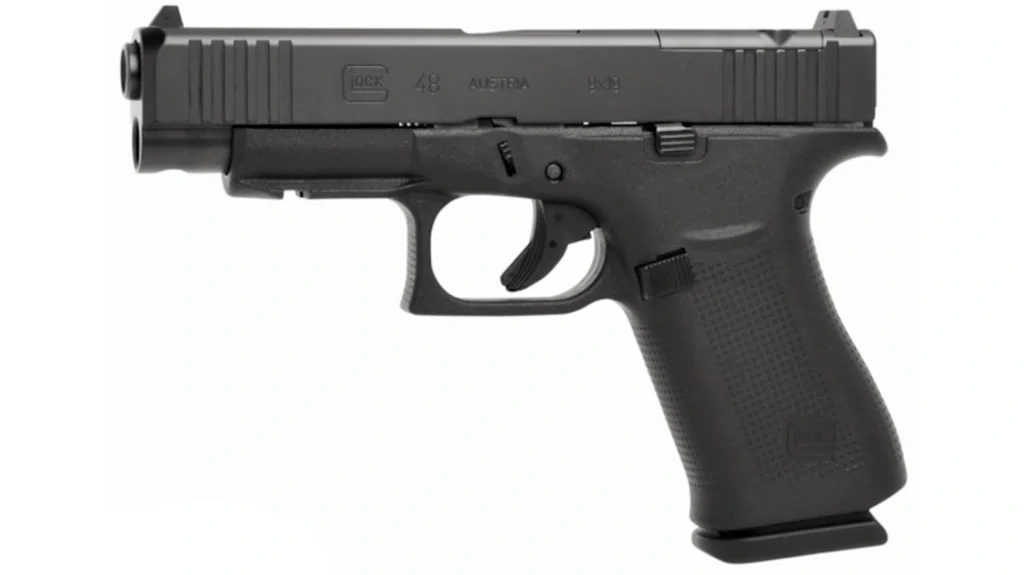
The Glock 48 has the same grip as the 43X but sports a barrel and slide length comparable to the Glock 19. In theory, the longer grip allows for more surface area to grab on the draw and hold under recoil. The longer barrel, aside from giving marginally better ballistics, provides better balance and more recoil control over the shorter-barreled 43 family.
Advertisement — Continue Reading Below
With a magazine capacity of ten rounds, law enforcement agencies aren’t desperate to trade in their Model 17 and 19s for Glock 48s. But in the short term, the Glock 48 Slimline has achieved commercial success sufficient to warrant the debut of an optics-ready version in the Glock 48 MOS in 2020.
Glock 48 Quick Specs
| Caliber | 9mm Luger |
| Capacity | 10+1 |
| Barrel Length | 4.0 inches |
| Overall Length | 7.25 inches |
| Slide Width | 0.81 inch |
| Overall Width | 1.0 inch |
| Weight | 1 lb. 8 oz. (loaded) |
USA vs. Austria: Which Is Better?
Glock started in Austria but has been producing their wares directly in Smyrna, Georgia, since 2013. Both the Glock 19 and Glock 48 are made in both locations. That fact is stamped right on the right side of the slide. If confronted with samples from both countries, you might be asking yourself if the American-made Glock is better or worse than the Austrian-made version.
Advertisement — Continue Reading Below
Both versions look the same, and all parts interchange. The chief difference is that stamping on the slide and the finish it is treated with. Austrian Glocks continue to use the tough Tenifer finish that the brand is known for.
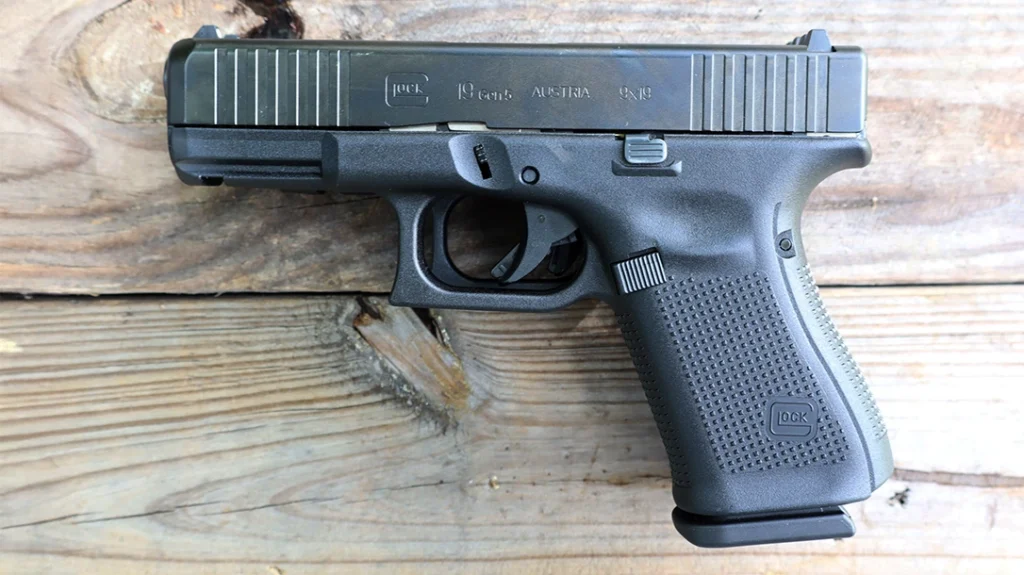
In the USA, Glock uses a diamond-like carbon coating on new Gen. 5 pistols. Previous generation pistols and Slimline models use a gas nitride finish. DLC coatings are tougher than nitride finishes, but nitride finishes impart more lubricity to the part they are applied to. The former excels with abuse, while the latter works better if the pistol lacks necessary lubrication.
Advertisement — Continue Reading Below
Tenifer provides a corrosion-resistant layer on the surface of metal, like the other finishes. However, it is the most durable of them. For those who foresee a harsh life for their handgun, all are good, but Tenifer is unbeatable.
Weigh In: Glock 19 vs. Glock 48
For our comparison, I have a new Glock 19 Gen 5 along with a Glock 48 MOS. Sans optic, the Glock 48 is a diet version of the Glock 19. Side by side, the Glock 19 matches the Glock 48 in height.
The G48 is ever so slightly longer in overall length with a more pronounced backstrap and beavertail. The Glock 48’s squared-off trigger guard is more setback. However, the dimensions are so slight that it still fits within the G19’s profile.
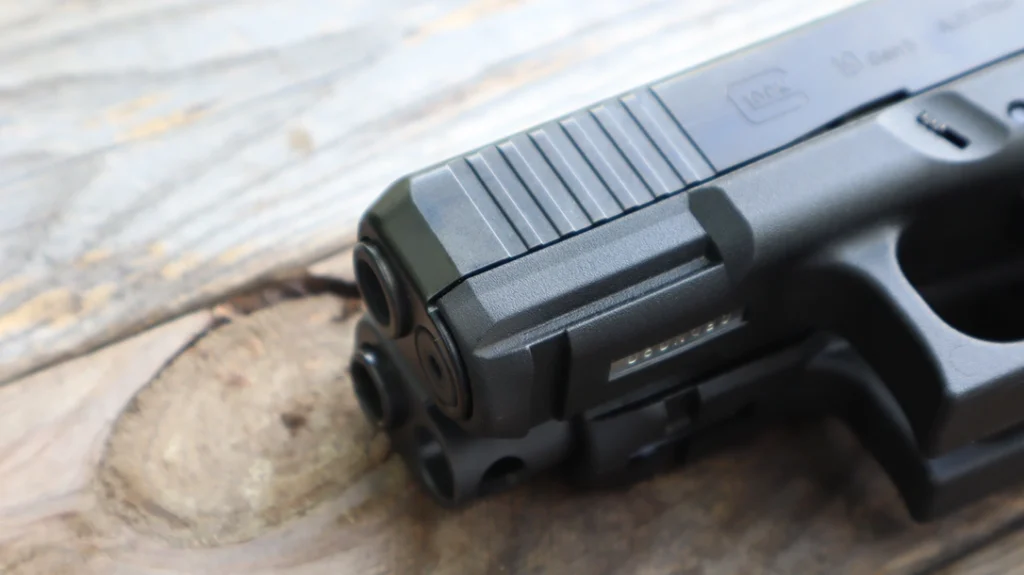
The most noticeable difference is width. For all intents and purposes, the Glock 48 and Glock 19 are comparable in size. However, the G48’s single-stack magazine allows for a slimmer grip and slide.
The 48 is up to ¼ of an inch slimmer. The trade-off is a reduction of magazine capacity from fifteen rounds to ten rounds. Altogether, this shaves off 6.5 ounces of loaded weight compared to the 19.
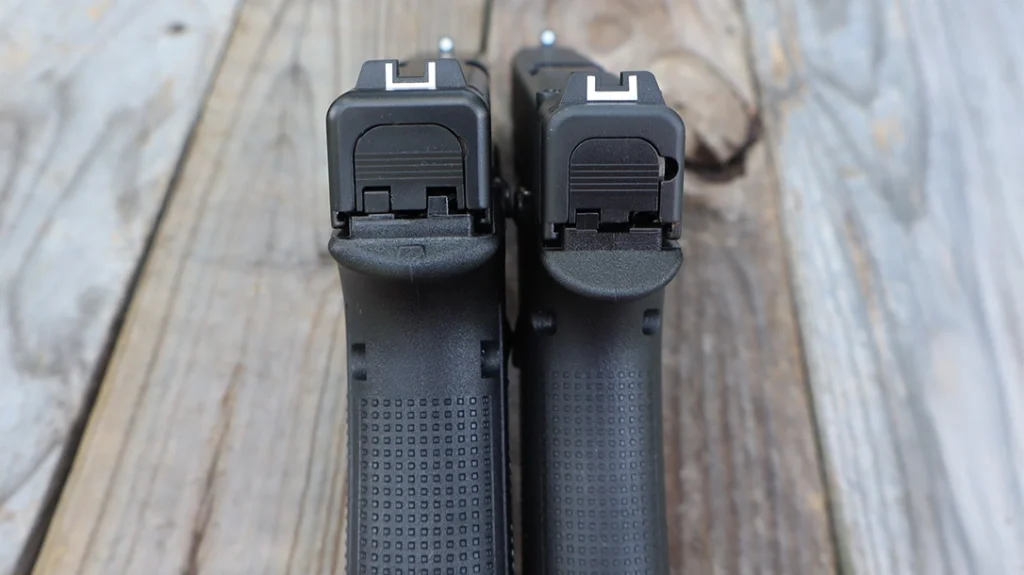
G19 & G48 Ergonomics
These are the latest versions of the Glock 19 and Glock 48. The G19 comes with a standard front white dotted post sight paired with a square-notch rear bracketed by a white outline. This is par for the course for most Glock models. The G48 uses the same front sight and a rear sight that is slightly smaller than the 19.
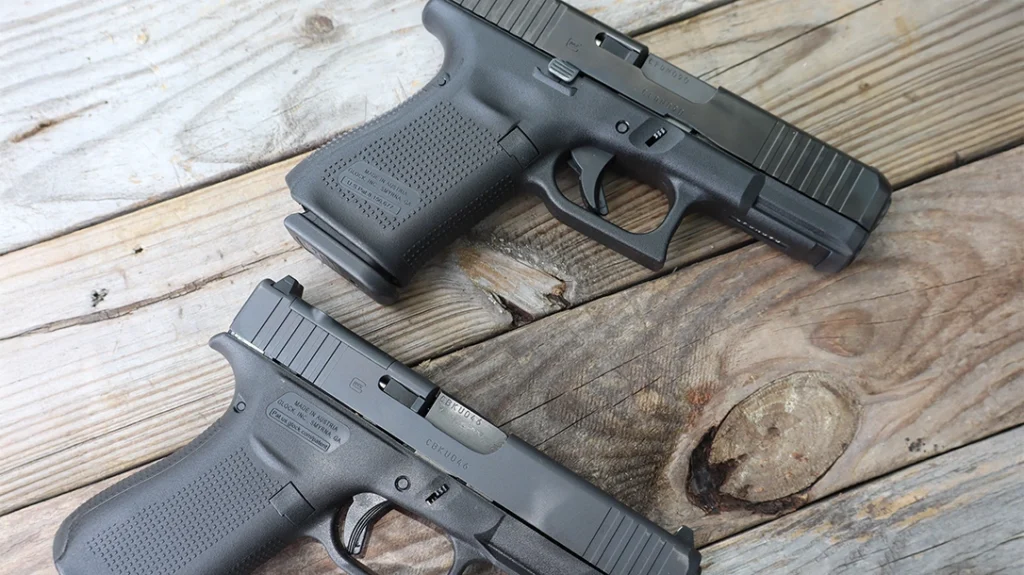
The Gen 5 Glock 19 features a light rail, forward and rearward cocking serrations, an ambidextrous slide release, and a reversible magazine release button. The Glock 48’s magazine release is reversible, but it retains only a right-handed slide release. In addition, the standard Glock 48 does not have a light rail. This MOS version has a smaller rail for a compact light.
Glock 48 vs. Glock 19: Shooting Impressions
Side by side on the firing line, both the Glock 19 and Glock 48 are solid performers. Despite their looks and close features, on the range is where the differences become more consequential.
When it comes to the Glock 48, the grip can either make or break the decision to buy. The thinner grip allows the hand to reach the magazine release, slide release, and trigger more easily. Those with smaller hands can struggle to get a good firing grip with the thicker double-stack grip of the 19.
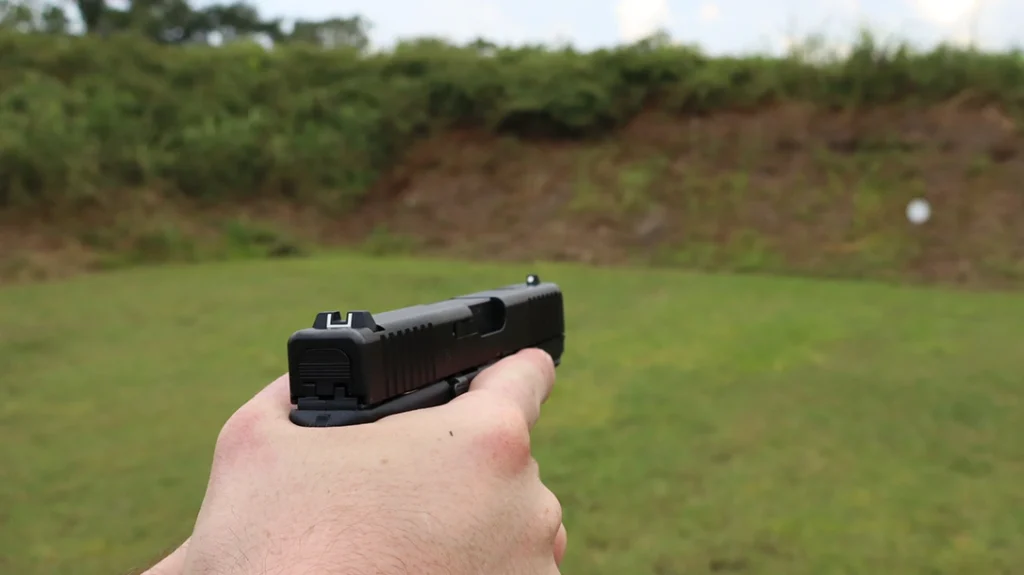
Conversely, the Glock 48’s thinner grip translates to less surface area along the palm. This, combined with several ounces of less weight, makes felt recoil more pronounced. The inverse is true with the Glock 19. That wider grip and additional weight diminish felt recoil and muzzle rise.
Both handguns produce identical accuracy mechanically, given they have similar features and identical barrel length and sight radius. But the Glock 19 is measurably faster to shoot. Using standard pressure Magtech 115-grain FMJ, I shot a set of timed ten-shot groups with both pistols.
At ten yards, to achieve the same accuracy, I shot the Glock 48 about two seconds slower than the Glock 19.
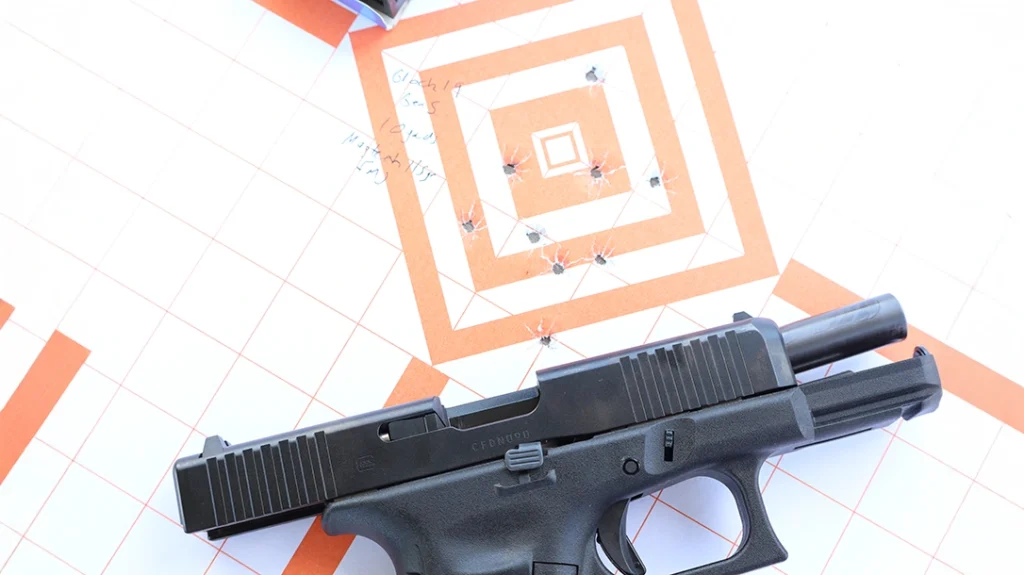
Making the Case
The Glock 19 and Glock 48 can be relied upon to do the job. Whether you pick the full sugar or the diet version will be all about the variables.
If you have smaller hands or are looking for overall ease of carry, the Glock 48 gets the nod. On the other hand, it is a little slower to shoot and lacks the overall aftermarket support of the Glock 19—at least for now.
If you can reach the controls without issue and do not mind double-stack bulk in exchange for double-stack capacity, the Glock 19 will be a rewarding choice.
Between the two, which would you choose?



